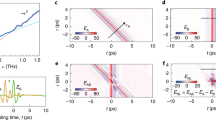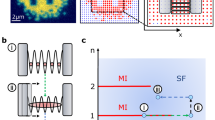Abstract
Angle-resolved photoemission spectroscopy (ARPES) measures the single-particle excitations of a many-body quantum system with energy and momentum resolution, providing detailed information about strongly interacting materials1. ARPES directly probes fermion pairing, and hence is a natural technique to study the development of superconductivity in systems ranging from high-temperature superconductors to unitary Fermi gases. In these systems, a remnant gap-like feature persists in the normal state2. Developing a quantitative understanding of these so-called pseudogap regimes may elucidate details about the pairing mechanisms that lead to superconductivity, but this is difficult in real materials partly because the microscopic Hamiltonian is not known. Here, we report on the development of ARPES to study strongly interacting fermions in an optical lattice using a quantum gas microscope. We benchmark the technique by measuring the occupied single-particle spectral function of an attractive Fermi–Hubbard system across the BCS–BEC crossover and comparing the results to those of quantum Monte Carlo calculations. We find evidence for a pseudogap that opens well above the expected critical temperature for superfluidity. This technique may also be applied to the doped repulsive Hubbard model, which is expected to exhibit a pseudogap at temperatures close to those achieved in recent experiments3.
This is a preview of subscription content, access via your institution
Access options
Access Nature and 54 other Nature Portfolio journals
Get Nature+, our best-value online-access subscription
$29.99 / 30 days
cancel any time
Subscribe to this journal
Receive 12 print issues and online access
$209.00 per year
only $17.42 per issue
Buy this article
- Purchase on Springer Link
- Instant access to full article PDF
Prices may be subject to local taxes which are calculated during checkout




Similar content being viewed by others
Data availability
The data displayed in Figs. 1–4 are available online at https://doi.org/10.17605/OSF.IO/UEFP8. Supporting data generated during the current study are available from the corresponding author on reasonable request.
Code availability
The code to reproduce the analysis in this study is available from the corresponding author on reasonable request.
References
Damascelli, A., Hussain, Z. & Shen, Z.-X. Angle-resolved photoemission studies of the cuprate superconductors. Rev. Mod. Phys. 75, 473–541 (2003).
Mueller, E. J. Review of pseudogaps in strongly interacting Fermi gases. Rep. Prog. Phys. 80, 104401 (2017).
Mazurenko, A. et al. A cold-atom Fermi–Hubbard antiferromagnet. Nature 545, 462–466 (2017).
Chen, Q., He, Y., Chien, C.-C. & Levin, K. Theory of radio frequency spectroscopy experiments in ultracold Fermi gases and their relation to photoemission in the cuprates. Rep. Prog. Phys. 72, 122501 (2009).
Törmä, P. Physics of ultracold Fermi gases revealed by spectroscopies. Phys. Scr. 91, 043006 (2016).
Vishik, I. M. et al. ARPES studies of cuprate fermiology: superconductivity, pseudogap and quasiparticle dynamics. New J. Phys. 12, 105008 (2010).
Hasan, M. Z. & Kane, C. L. Colloquium: topological insulators. Rev. Mod. Phys. 82, 3045–3067 (2010).
Chin, C. et al. Observation of the pairing gap in a strongly interacting Fermi gas. Science 305, 1128–1130 (2004).
Schunck, C. H., Shin, Y., Schirotzek, A., Zwierlein, M. W. & Ketterle, W. Pairing without superfluidity: the ground state of an imbalanced Fermi mixture. Science 316, 867–870 (2007).
Gaebler, J. P. et al. Observation of pseudogap behaviour in a strongly interacting Fermi gas. Nat. Phys. 6, 569–573 (2010).
Nascimbène, S. et al. Fermi-liquid behavior of the normal phase of a strongly interacting gas of cold atoms. Phys. Rev. Lett. 106, 215303 (2011).
Feld, M., Fröhlich, B., Vogt, E., Koschorreck, M. & Köhl, M. Observation of a pairing pseudogap in a two-dimensional Fermi gas. Nature 480, 75–78 (2011).
Sommer, A. T., Cheuk, L. W., Ku, M. J. H., Bakr, W. S. & Zwierlein, M. W. Evolution of fermion pairing from three to two dimensions. Phys. Rev. Lett. 108, 045302 (2012).
Murthy, P. A. et al. High-temperature pairing in a strongly interacting two-dimensional Fermi gas. Science 359, 452–455 (2017).
Dao, T.-L., Georges, A., Dalibard, J., Salomon, C. & Carusotto, I. Measuring the one-particle excitations of ultracold fermionic atoms by stimulated Raman spectroscopy. Phys. Rev. Lett. 98, 240402 (2007).
Stewart, J. T., Gaebler, J. P. & Jin, D. S. Using photoemission spectroscopy to probe a strongly interacting Fermi gas. Nature 454, 744–747 (2008).
Sagi, Y., Drake, T. E., Paudel, R., Chapurin, R. & Jin, D. S. Breakdown of the Fermi liquid description for strongly interacting fermions. Phys. Rev. Lett. 114, 075301 (2015).
Fröhlich, B. et al. Two-dimensional Fermi liquid with attractive interactions. Phys. Rev. Lett. 109, 130403 (2012).
Schneider, W. & Randeria, M. Universal short-distance structure of the single-particle spectral function of dilute Fermi gases. Phys. Rev. A 81, 021601 (2010).
Loktev, V. M., Quick, R. M. & Sharapov, S. G. Phase fluctuations and pseudogap phenomena. Phys. Rep. 349, 1–123 (2001).
Perali, A., Pieri, P., Strinati, G. C. & Castellani, C. Pseudogap and spectral function from superconducting fluctuations to the bosonic limit. Phys. Rev. B 66, 024510 (2002).
Perali, A. et al. Evolution of the normal state of a strongly interacting Fermi gas from a pseudogap phase to a molecular Bose gas. Phys. Rev. Lett. 106, 060402 (2011).
Wurz, N. et al. Coherent manipulation of spin correlations in the Hubbard model. Phys. Rev. A 97, 051602 (2018).
Murthy, P. A. et al. Matter-wave Fourier optics with a strongly interacting two-dimensional Fermi gas. Phys. Rev. A 90, 043611 (2014).
Bohrdt, A., Greif, D., Demler, E., Knap, M. & Grusdt, F. Angle-resolved photoemission spectroscopy with quantum gas microscopes. Phys. Rev. B 97, 125117 (2018).
Strohmaier, N. et al. Interaction-controlled transport of an ultracold Fermi gas. Phys. Rev. Lett. 99, 220601 (2007).
Hackermuller, L. et al. Anomalous expansion of attractively interacting fermionic atoms in an optical lattice. Science 327, 1621–1624 (2010).
Schneider, U. et al. Fermionic transport and out-of-equilibrium dynamics in a homogeneous Hubbard model with ultracold atoms. Nat. Phys. 8, 213–218 (2012).
Mitra, D. et al. Quantum gas microscopy of an attractive Fermi–Hubbard system. Nat. Phys. 14, 173–177 (2017).
Paiva, T., dos Santos, R. R., Scalettar, R. T. & Denteneer, P. J. H. Critical temperature for the two-dimensional attractive Hubbard model. Phys. Rev. B 69, 184501 (2004).
Singer, J. M., Pedersen, M. H., Schneider, T., Beck, H. & Matuttis, H.-G. From BCS-like superconductivity to condensation of local pairs: a numerical study of the attractive Hubbard model. Phys. Rev. B 54, 1286–1301 (1996).
Singer, J. M., Schneider, T. & Pedersen, M. H. On the phase diagram of the attractive Hubbard model: crossover and quantum critical phenomena. Eur. Phys. J. B 2, 17–30 (1998).
Singer, J. M., Schneider, T. & Meier, P. F. Spectral properties of the attractive Hubbard model. Eur. Phys. J. B 7, 37–51 (1999).
Brown, P. T. et al. Bad metallic transport in a cold atom Fermi–Hubbard system. Science 363, 379–382 (2019).
Nichols, M. A. et al. Spin transport in a Mott insulator of ultracold fermions. Science 363, 383–387 (2019).
Xu, W., Haule, K. & Kotliar, G. Hidden Fermi liquid, scattering rate saturation, and Nernst effect: a dynamical mean-field theory perspective. Phys. Rev. Lett. 111, 036401 (2013).
Deng, X. et al. How bad metals turn good: spectroscopic signatures of resilient quasiparticles. Phys. Rev. Lett. 110, 086401 (2013).
Grusdt, F. et al. Parton theory of magnetic polarons: mesonic resonances and signatures in dynamics. Phys. Rev. X 8, 011046 (2018).
O’Hara, K. M., Gehm, M. E., Granade, S. R., Bali, S. & Thomas, J. E. Stable, strongly attractive, two-state mixture of lithium fermions in an optical trap. Phys. Rev. Lett. 85, 2092–2095 (2000).
Acknowledgements
This work was supported by the NSF (grant no. DMR-1607277), the David and Lucile Packard Foundation (grant no. 2016-65128) and the AFOSR Young Investigator Research Program (grant no. FA9550-16-1-0269). T.P.D. and E.W.H. acknowledge support from the US Department of Energy, Office of Science, Office of Basic Energy Sciences, Division of Materials Sciences and Engineering, under contract no. DE-AC02-76SF00515. Computational work was performed on the Sherlock cluster at Stanford University.
Author information
Authors and Affiliations
Contributions
P.T.B. and W.S.B. conceived the experiment. P.T.B., E.G.-S. and B.M.S. collected the experimental data and performed the data analysis. E.W.H. and T.P.D. performed the quantum Monte Carlo calculations. T.P.D. and W.S.B. supervised the project. All authors contributed to the writing of the manuscript.
Corresponding author
Ethics declarations
Competing interests
The authors declare no competing interests.
Additional information
Publisher’s note Springer Nature remains neutral with regard to jurisdictional claims in published maps and institutional affiliations.
Supplementary information
Supplementary Information
Supplementary text, Figs. 1–7 and references.
Supplementary Data
Text files containing the data plotted in Figs. 1–4.
Rights and permissions
About this article
Cite this article
Brown, P.T., Guardado-Sanchez, E., Spar, B.M. et al. Angle-resolved photoemission spectroscopy of a Fermi–Hubbard system. Nat. Phys. 16, 26–31 (2020). https://doi.org/10.1038/s41567-019-0696-0
Received:
Accepted:
Published:
Issue Date:
DOI: https://doi.org/10.1038/s41567-019-0696-0
This article is cited by
-
Frustration- and doping-induced magnetism in a Fermi–Hubbard simulator
Nature (2023)
-
Dichotomy of heavy and light pairs of holes in the t−J model
Nature Communications (2023)
-
Quantum simulations with ultracold atoms in optical lattices: past, present and future
Journal of the Korean Physical Society (2023)
-
Quantum gas microscopy for single atom and spin detection
Nature Physics (2021)
-
Spectroscopic probes of quantum gases
Nature Physics (2021)



